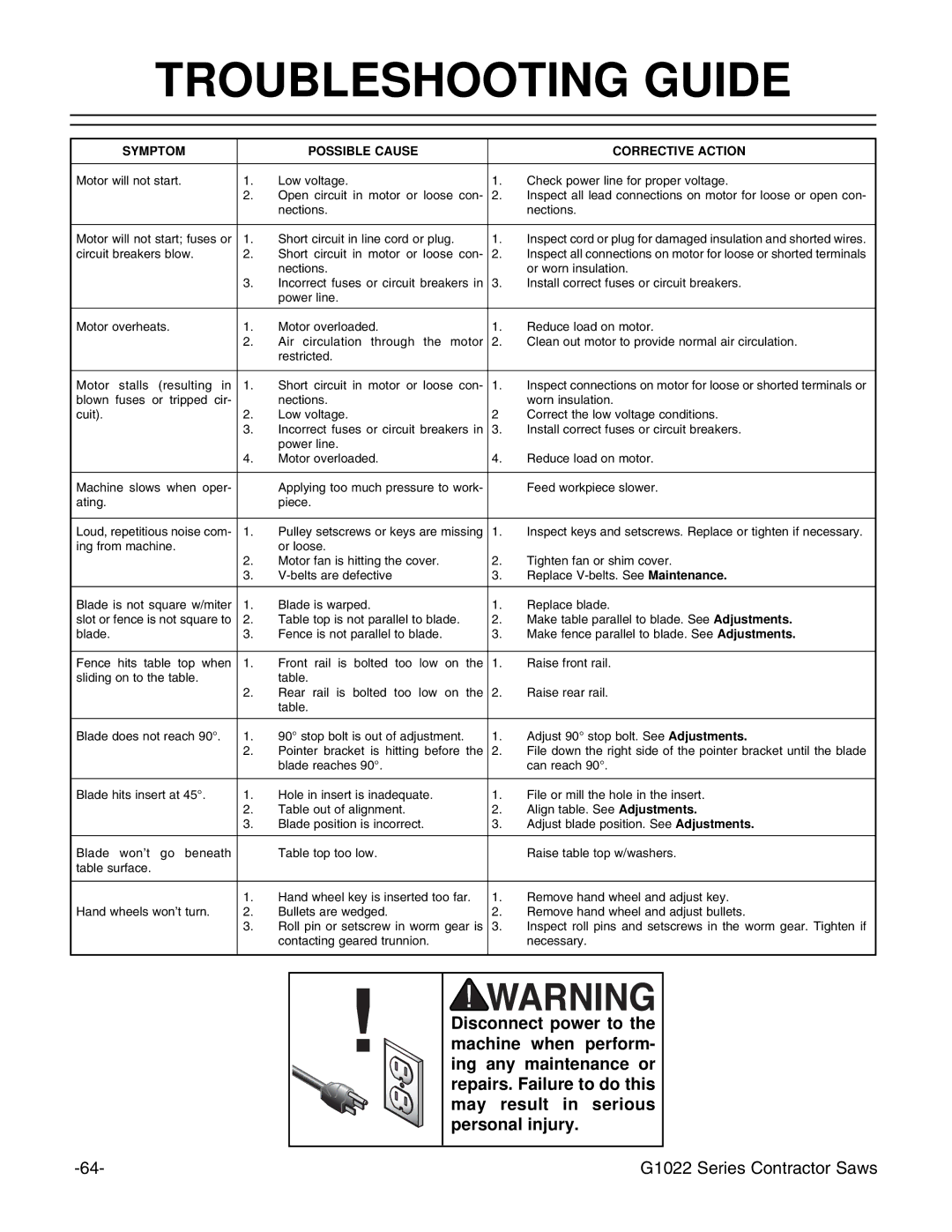
TROUBLESHOOTING GUIDE
| SYMPTOM |
| POSSIBLE CAUSE |
| CORRECTIVE ACTION | |
|
|
|
|
| ||
Motor will not start. | 1. | Low voltage. | 1. | Check power line for proper voltage. | ||
|
|
| 2. | Open circuit in motor or loose con- | 2. | Inspect all lead connections on motor for loose or open con- |
|
|
|
| nections. |
| nections. |
|
|
|
|
| ||
Motor will not start; fuses or | 1. | Short circuit in line cord or plug. | 1. | Inspect cord or plug for damaged insulation and shorted wires. | ||
circuit breakers blow. | 2. | Short circuit in motor or loose con- | 2. | Inspect all connections on motor for loose or shorted terminals | ||
|
|
|
| nections. |
| or worn insulation. |
|
|
| 3. | Incorrect fuses or circuit breakers in | 3. | Install correct fuses or circuit breakers. |
|
|
|
| power line. |
|
|
|
|
|
|
| ||
Motor overheats. | 1. | Motor overloaded. | 1. | Reduce load on motor. | ||
|
|
| 2. | Air circulation through the motor | 2. | Clean out motor to provide normal air circulation. |
|
|
|
| restricted. |
|
|
|
|
|
|
|
|
|
Motor | stalls | (resulting in | 1. | Short circuit in motor or loose con- | 1. | Inspect connections on motor for loose or shorted terminals or |
blown fuses or tripped cir- |
| nections. |
| worn insulation. | ||
cuit). |
|
| 2. | Low voltage. | 2 | Correct the low voltage conditions. |
|
|
| 3. | Incorrect fuses or circuit breakers in | 3. | Install correct fuses or circuit breakers. |
|
|
|
| power line. |
|
|
|
|
| 4. | Motor overloaded. | 4. | Reduce load on motor. |
|
|
|
|
| ||
Machine slows when oper- |
| Applying too much pressure to work- |
| Feed workpiece slower. | ||
ating. |
|
|
| piece. |
|
|
|
|
|
|
| ||
Loud, repetitious noise com- | 1. | Pulley setscrews or keys are missing | 1. | Inspect keys and setscrews. Replace or tighten if necessary. | ||
ing from machine. |
| or loose. |
|
| ||
|
|
| 2. | Motor fan is hitting the cover. | 2. | Tighten fan or shim cover. |
|
|
| 3. | 3. | Replace | |
|
|
|
|
| ||
Blade is not square w/miter | 1. | Blade is warped. | 1. | Replace blade. | ||
slot or fence is not square to | 2. | Table top is not parallel to blade. | 2. | Make table parallel to blade. See Adjustments. | ||
blade. |
|
| 3. | Fence is not parallel to blade. | 3. | Make fence parallel to blade. See Adjustments. |
|
|
|
|
| ||
Fence hits table top when | 1. | Front rail is bolted too low on the | 1. | Raise front rail. | ||
sliding on to the table. |
| table. |
|
| ||
|
|
| 2. | Rear rail is bolted too low on the | 2. | Raise rear rail. |
|
|
|
| table. |
|
|
|
|
|
|
| ||
Blade does not reach 90¡. | 1. | 90¡ stop bolt is out of adjustment. | 1. | Adjust 90¡ stop bolt. See Adjustments. | ||
|
|
| 2. | Pointer bracket is hitting before the | 2. | File down the right side of the pointer bracket until the blade |
|
|
|
| blade reaches 90¡. |
| can reach 90¡. |
|
|
|
|
| ||
Blade hits insert at 45¡. | 1. | Hole in insert is inadequate. | 1. | File or mill the hole in the insert. | ||
|
|
| 2. | Table out of alignment. | 2. | Align table. See Adjustments. |
|
|
| 3. | Blade position is incorrect. | 3. | Adjust blade position. See Adjustments. |
|
|
|
|
|
|
|
Blade | wonÕt | go beneath |
| Table top too low. |
| Raise table top w/washers. |
table surface. |
|
|
|
|
| |
|
|
|
|
|
|
|
|
|
| 1. | Hand wheel key is inserted too far. | 1. | Remove hand wheel and adjust key. |
Hand wheels wonÕt turn. | 2. | Bullets are wedged. | 2. | Remove hand wheel and adjust bullets. | ||
|
|
| 3. | Roll pin or setscrew in worm gear is | 3. | Inspect roll pins and setscrews in the worm gear. Tighten if |
|
|
|
| contacting geared trunnion. |
| necessary. |
|
|
|
|
|
|
|
!
Disconnect power to the machine when perform- ing any maintenance or repairs. Failure to do this may result in serious personal injury.
G1022 Series Contractor Saws |
